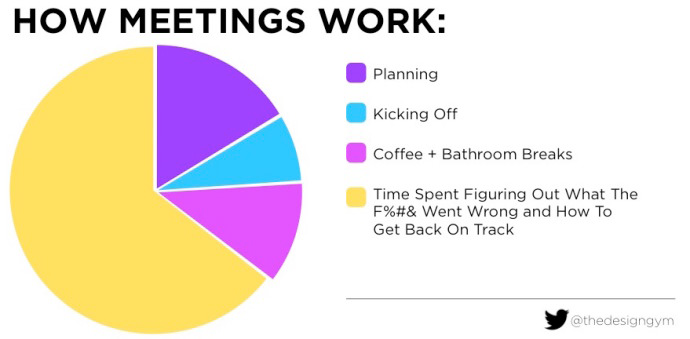
10 steps to effective meetings
Did you know ?
Every day 83 million people attend 11.5 million meetings
No ? OK, lets get started
Meetings, a fancy word in corporate that everyone come across a lot many times (For some it can be a very effective excuse to avoid other things though :-P)
Meetings are integral part of any process oriented organization.
It makes sense to meet every while to get the status updates, near future plans, project deadlines, company future projection etc.
Now why I am writing this post is because something is wrong with meetings most of the time that we should improve.
Meetings? Or time eaters
When you call for a meeting, you get your team out of their working momentum.
The meeting is scheduled for say 1 hour but actually it is 10–12 hour trade off for something that we mostly spend on discussing causal things.
10 people * 1 hour = 10 hours
+2–3 hours to get them back to the momentum
So meetings are simple time eaters of productive hours if not organized well.
Planned vs out of focus discussion
Most of the time we plan a meeting as soon as we feel to meet because it looks fancy to be a part of meeting. And we end up sending invites without planning attendees and the clear agenda communication.
Most of the meeting attendees do not do their homework and this leads to discussions which should be clarified before meeting.

Image source : http://www.thedesigngym.com
This leads to out of scope discussions and elongated meetings. Sometimes meetings procreate more meetings as well.
What should you do?
Meetings are like toxic if not planned properly.
First and most effective is
Avoid meetings until unavoidable 

Image source : https://media.licdn.com
Simulate it as hitting the gym,
You find reasons to avoid going to the gym. But once you realize that you are out of shape you forcefully go with all the diet plan and schedule.
Treat meetings the same as above.
Invite fewest possible
Invite only those who can have positive impact on the quality of discussion. It not only adds quality but also saves a lot of time for other indirect attendees.
Educate everyone about it
Send clear meeting invites with start, end time and duration so that everyone can make their mind and plan their day accordingly. Send reminders so that everyone keeps up with agenda and time.
Clear agenda to the attendees
Mention the agenda clearly and if possible assign the kind of homework you want each attendee to come prepared with.
Welcome with specific problem
The meeting organizer should welcome them all on time (without wasting a single minute).
Meeting should start with a brief introduction about the purpose of this meeting.
It should be very transparent about the past happenings or future projections to everyone.
Fixed duration meetings
The duration you mentioned in the invitation mail should be like a promise.
Like we get out of gym as soon as we hit the clockremember?
Hit the stopwatch as soon as it interrupts you with a noise call it the end of meeting.
Meet on site of crime (if possible)
Most of the times we meet at conference rooms. This is good practice to get aside of the workplace to avoid disturbing others.
However meeting at the place of reason behind meeting brings a lot of clarity. You can make signs to the real things and can have a look at something important present there and then.
It saves you a lot of time and the promises to get back on something later.
Minutes of meeting
Make someone accountable to make a not of meeting highlights. This can be very helpful for those who are not direct stakeholders of that meeting.
Also these MOMs can be referenced later to remember what we discussed in the meeting ( say 3 months ago ).
Make someone Accountable for plan
We meet to induce something out of meetings. Some action plan, some investigation to be done etc.
Most of the times, the plan remains untouched. It is advised to make someone accountable to come back with the results in a stipulated time.
No meetings Thursdays
You can also decide not to do any meetings on Thursdays.
(Not compulsorily Thursday, you can plan as per your convenience)
This will save you about say
10 meetings for 10 departments
Each meeting on average is around 1 hour
And each meeting have average 10 attendees.
So 10 meetings * 1 hour * (10) people
Is 100 productive hours in which you can complete around 10 stories.
Other Knicks-knacks
- Keep your phone silent
- Always be on time
- Come prepared with homework
- Work on the outcome from meeting
- Avoid snacks and talks about the movie you watched at weekend or your new jumpsuit.
- One most important one is –
Keep smiling and be pro(a/du)ctive.
I will keep sharing my experiences with you in return
I want you all to recommend it if you find it can be of help to someone.
Author : Rohit Sharma
Comments
Post a Comment